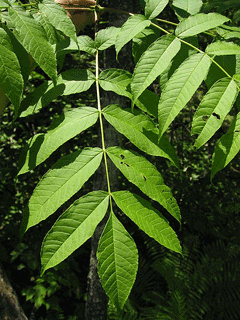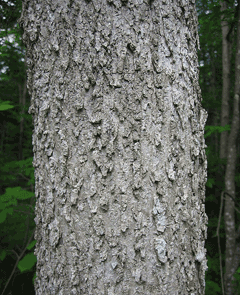 |
|
http://commons.wikimedia.org/wiki/User:MPF |
 |
| http://commons.wikimedia.org/wiki/User:MPF |
Translate this page:
Summary
Bloom Color: Green. Main Bloom Time: Early spring, Late spring, Mid spring.Form: Oval, Rounded.
Physical Characteristics

 Fraxinus nigra is a deciduous Tree growing to 25 m (82ft 0in) at a medium rate.
Fraxinus nigra is a deciduous Tree growing to 25 m (82ft 0in) at a medium rate.
See above for USDA hardiness. It is hardy to UK zone 7 and is not frost tender. The species is dioecious (individual flowers are either male or female, but only one sex is to be found on any one plant so both male and female plants must be grown if seed is required). and is pollinated by Wind. The plant is not self-fertile.
Suitable for: light (sandy), medium (loamy) and heavy (clay) soils. Suitable pH: mildly acid, neutral and basic (mildly alkaline) soils. It cannot grow in the shade. It prefers moist or wet soil. The plant can tolerates strong winds but not maritime exposure.
It can tolerate atmospheric pollution.
UK Hardiness Map
US Hardiness Map
Synonyms
F. sambucifolia.
Plant Habitats
Woodland Garden Canopy; Bog Garden;
Edible Uses
References More on Edible Uses
Medicinal Uses
Plants For A Future can not take any responsibility for any adverse effects from the use of plants. Always seek advice from a professional before using a plant medicinally.
Diaphoretic Diuretic Laxative Ophthalmic Tonic
The leaves are diaphoretic, diuretic, laxative[4]. They should be gathered in June, well dried and stored in airtight containers[4]. The inner bark has been used as a tonic for the liver and stomach, to check vaginal discharge and to treat painful urination[257]. An infusion of the inner bark has been used as an eye wash for sore eyes[257].
References More on Medicinal Uses
The Bookshop: Edible Plant Books
Our Latest books on Perennial Plants For Food Forests and Permaculture Gardens in paperback or digital formats.

Edible Tropical Plants
Food Forest Plants for Hotter Conditions: 250+ Plants For Tropical Food Forests & Permaculture Gardens.
More

Edible Temperate Plants
Plants for Your Food Forest: 500 Plants for Temperate Food Forests & Permaculture Gardens.
More

More Books
PFAF have eight books available in paperback and digital formats. Browse the shop for more information.
Shop Now
Other Uses
Basketry Dye Fuel Wood
Logs of wood can be beaten with mauls to separate the growth layers, these layers can then be cut into strips and woven into baskets[257]. A blue dye can be obtained from the bark[257]. Wood - not strong, rather soft, durable, heavy, tough, coarse-grained, easily separated into thin layers. It weighs 39lb per cubic foot. Largely used for making furniture, cabinet making, interior finish and veneer[46, 61, 82, 171, 229, 235]. The wood makes a good fuel, it does not crackle or shoot sparks like many other woods[257]. If the wood is soaked in water and then pounded, it separates easily into thin sheets[226]. These sheets have then been used to make woven baskets, barrel hoops, chair seats etc[226].
Special Uses
References More on Other Uses
Cultivation details
Prefers a deep loamy soil, even if it is on the heavy side[1, 200]. Most members of this genus are gross feeders and require a rich soil[11, 200]. A plant of swamps in the wild, in Britain this species requires a moist to wet soil[200]. It succeeds when growing in exposed positions[200] and also in alkaline soils[11]. Plants are tolerant of atmospheric pollution[200]. A moderate to slow-growing tree in the wild[229], it is not a great success in Britain, where it is often damaged by late frosts[11]. This species is closely related to F. mandschurica[200]. Trees can bear hermaphrodite flowers, separate male and female flowers, or flowers of one sex only[229]. Special Features:
Not North American native, Inconspicuous flowers or blooms.
References Carbon Farming Information and Carbon Sequestration Information
Temperature Converter
Type a value in the Celsius field to convert the value to Fahrenheit:
Fahrenheit:
The PFAF Bookshop
Plants For A Future have a number of books available in paperback and digital form. Book titles include Edible Plants, Edible Perennials, Edible Trees,Edible Shrubs, Woodland Gardening, and Temperate Food Forest Plants. Our new book is Food Forest Plants For Hotter Conditions (Tropical and Sub-Tropical).
Shop Now
Plant Propagation
The seed is best harvested green - as soon as it is fully developed but before it has fully dried on the tree - and can then be sown immediately in a cold frame[80]. It usually germinates in the spring[80]. Stored seed requires a period of cold stratification and is best sown as soon as possible in a cold frame[200]. Prick out the seedlings into individual pots when they are large enough to handle and grow them on in a cold frame for their first winter. Plant them out into their permanent positions or a nursery bed in late spring or early summer of the following year. If you have sufficient seed then it is possible to sow it directly into an outdoor seedbed, preferably in the autumn. Grow the seedlings on in the seedbed for 2 years before transplanting either to their permanent positions or to nursery beds.
Other Names
If available other names are mentioned here
Native Range
NORTHERN AMERICA: Canada (Québec (south), Nova Scotia, Ontario, Prince Edward Island, New Brunswick, Newfoundland and Labrador (west), Manitoba (southeast)), United States (Connecticut, Indiana, Maine, Massachusetts, Michigan, New Hampshire, New Jersey, New York, Ohio, Pennsylvania, Rhode Island, Vermont, West Virginia, Illinois, Iowa, Minnesota, North Dakota (northeast), Wisconsin, Delaware (north), Maryland (north), Virginia (north))
Weed Potential
Right plant wrong place. We are currently updating this section.
Please note that a plant may be invasive in one area but may not in your area so it's worth checking.
Conservation Status
IUCN Red List of Threatened Plants Status :

Growth: S = slow M = medium F = fast. Soil: L = light (sandy) M = medium H = heavy (clay). pH: A = acid N = neutral B = basic (alkaline). Shade: F = full shade S = semi-shade N = no shade. Moisture: D = dry M = Moist We = wet Wa = water.
Now available:
Food Forest Plants for Mediterranean Conditions
350+ Perennial Plants For Mediterranean and Drier Food Forests and Permaculture Gardens.
[Paperback and eBook]
This is the third in Plants For A Future's series of plant guides for food forests tailored to
specific climate zones. Following volumes on temperate and tropical ecosystems, this book focuses
on species suited to Mediterranean conditions—regions with hot, dry summers and cool, wet winters,
often facing the added challenge of climate change.
Read More
Expert comment
Author
Marshall.
Botanical References
1143200
Links / References
For a list of references used on this page please go here
Readers comment
| Add a comment |
|
If you have important information about this plant that may help other users please add a comment or link below. Only comments or links that are felt to be directly relevant to a plant will be included. If you think a comment/link or information contained on this page is inaccurate or misleading we would welcome your feedback at [email protected]. If you have questions about a plant please use the Forum on this website as we do not have the resources to answer questions ourselves.
* Please note: the comments by website users are not necessarily those held by PFAF and may give misleading or inaccurate information.
To leave a comment please Register or login here All comments need to be approved so will not appear immediately.
|
|